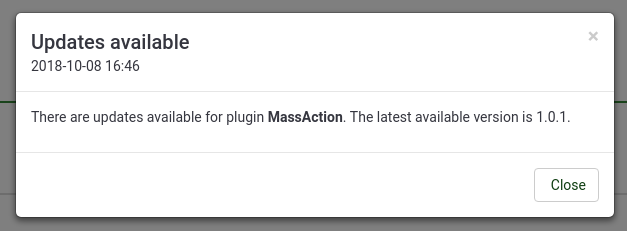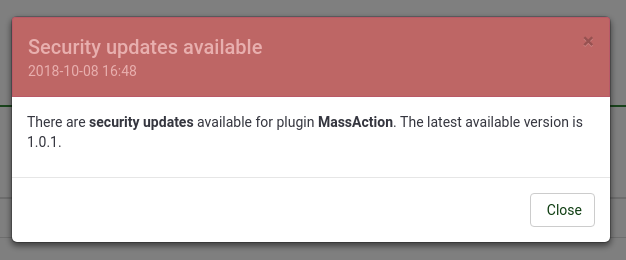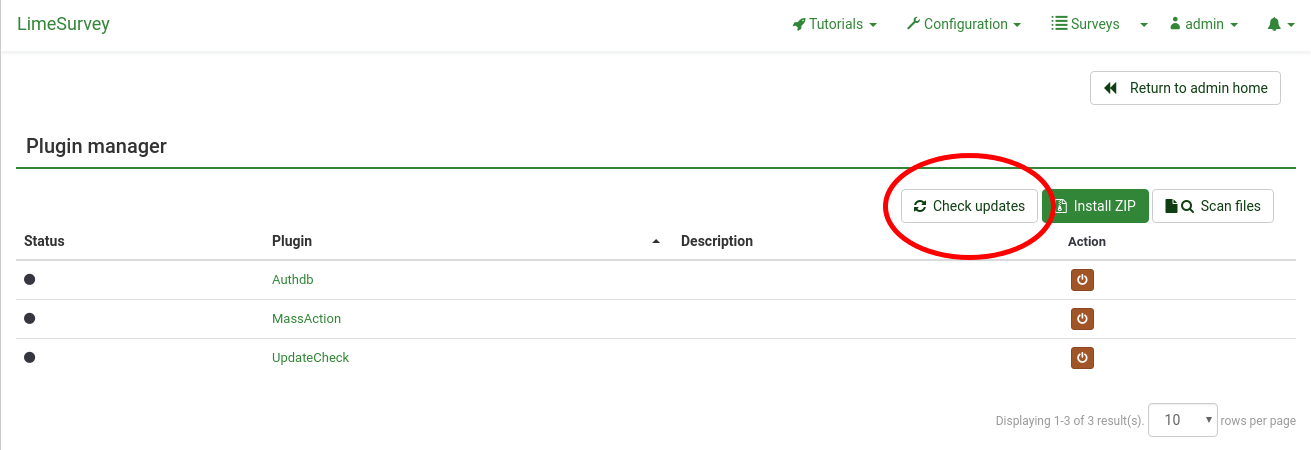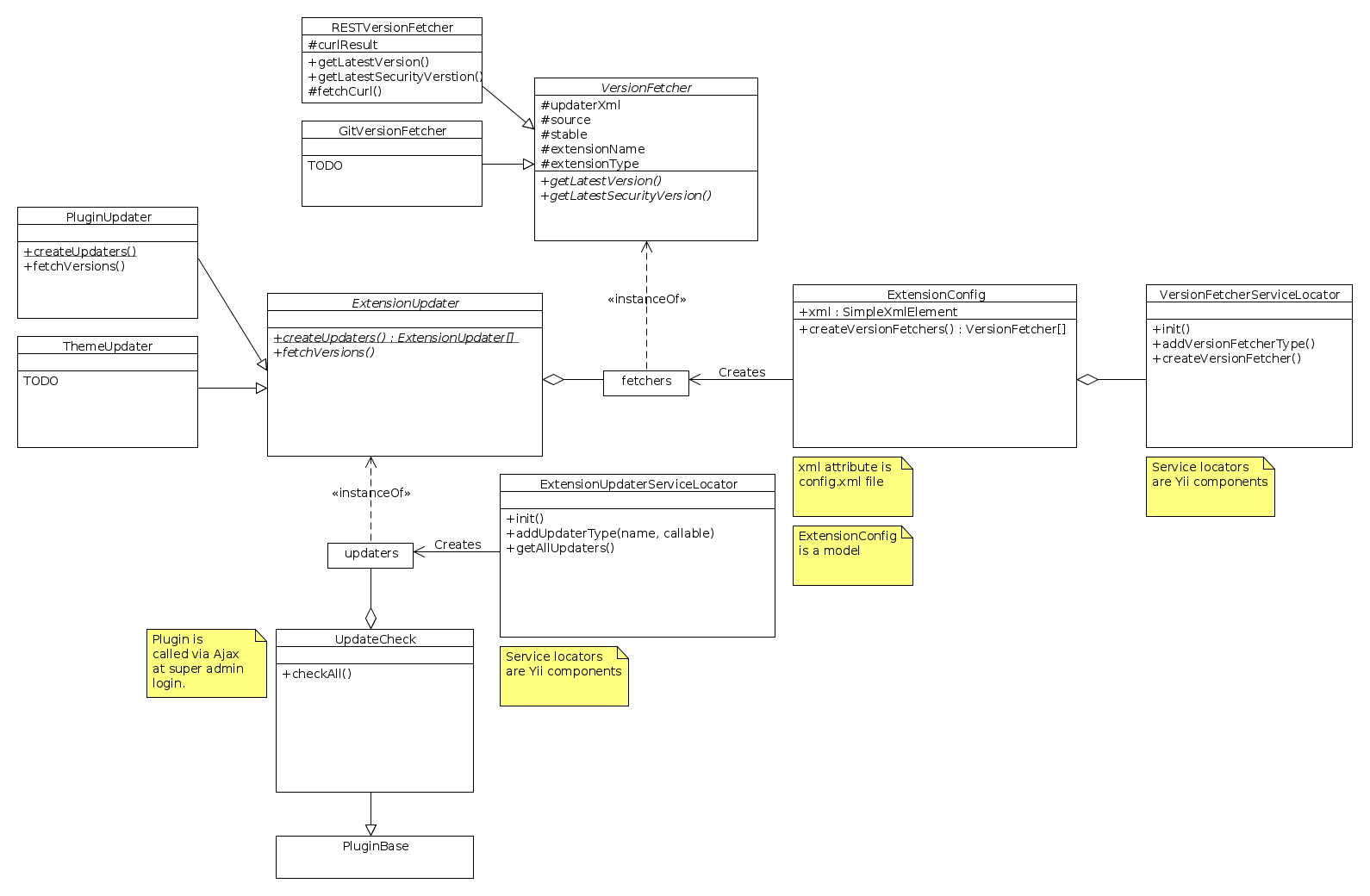Wtyczki - zaawansowane
From LimeSurvey Manual
Przegląd
Począwszy od LimeSurvey 2.05, LimeSurvey będzie oficjalnie wspierać wtyczki. Niektóre wtyczki będą obsługiwane przez zespół LimeSurvey i zostaną włączone do rdzenia. Niektórzy będą wspierani przez innych spoza zespołu LimeSurvey. Aby pomóc je znaleźć, sprawdź Dostępne wtyczki innych firm i dodaj do niej własną wtyczkę!
Wtyczki umożliwiają użytkownikom dostosowanie funkcjonalności ich instalacji, jednocześnie umożliwiając korzystanie z regularnych aktualizacji oprogramowania.
Niniejsza dokumentacja jest przeznaczona dla programistów, którzy rozszerzają LimeSurvey na własny użytek lub dla swoich klientów; ta dokumentacja nie pomoże użytkownikom końcowym.
Wtyczki muszą implementować interfejs iPlugin. Zalecamy rozszerzenie klasy wtyczki z klasy PluginBase.
Wtyczki są opracowywane w oparciu o mechanizm event.
Ustawienia wtyczki
Rozszerzając, zyskujesz wspólną funkcjonalność wymaganą przez wtyczki, które już dla Ciebie wdrożyliśmy. Jedną z takich funkcji jest implementacja funkcji getPluginSettings. Funkcja ta musi zwrócić tablicę opisującą opcje konfiguracyjne dla użytkownika.
Przykładowa wtyczka udostępnia tylko 1 konfigurowalne ustawienie, komunikat, który wyświetli.
protected $settings = array(
'logo' => array(
'type' => 'logo',
'path' => 'assets/logo.png'
) ,
'message' => array(
'type' => 'string',
'label' => 'Wiadomość'
)
);
Tablica zawiera nazwę każdego ustawienia jako klucz. Wartości to tablice zawierające wymagane metadane.
Obsługiwane typy to:
- logo
- int (liczba całkowita)
- string (alfanumeryczny)
- tekst
- html
- znaczenie
- info
- hasło
- data
- wybierz
Oprócz typu dostępnych jest wiele innych klawiszy:
- label, definiuje etykietę
- default, definiuje wartość wyświetlaną, jeśli nie określono żadnej wartości (tylko dla ustawień globalnych, nie dla ustawień ankiety)
- current, definiuje aktualną wartość.
- readOnly : pokazał ustawienia jako tylko do odczytu
- htmlOptions, htmlOptions części wejściowej (zobacz podręcznik Yii [[1]])
- pluginOptions, dla niektóre ustawienia (html lub wybierz): ustaw opcję widgetu
- labelOptions : htmlOpcje etykiety
- controlOptions : htmlOpcje opakowania etykiety i danych wejściowych
Przykład wtyczki wykorzystującej wszystkie aktualne ustawienia można znaleźć pod adresem exampleSettings
Odczyt i zapis ustawień wtyczki
Możliwe jest odczytywanie i zapisywanie ustawień wtyczki bezpośrednio z kodu wtyczki.
Przykład:
$mySetting = $this->get('mySetting');
$this->set('mySetting', $mojeSetting + 1);
Możesz uzyskać wartość domyślną, jeśli ustawienie ma wartość null:
$mySetting = $this->get('mySetting', null, null, 10); // 10 jest wartością domyślną
Wydarzenia
Wtyczki subskrybują zdarzenia i mogą wchodzić w interakcję z LimeSurvey po uruchomieniu zdarzenia. Listę aktualnie dostępnych wydarzeń znajdziesz w Wydarzenia wtyczek.
API
Wtyczki powinny rozszerzać LimeSurvey wyłącznie poprzez jego „publiczne” API. Oznacza to, że bezpośrednie używanie klas znajdujących się w kodzie źródłowym jest złą praktyką. Chociaż nie możemy Cię do tego zmusić, ryzykujesz uszkodzeniem wtyczki przy każdej drobnej aktualizacji, którą przeprowadzamy.
W miarę możliwości korzystaj z LimeSurvey wyłącznie metodami opisanymi tutaj. Podobnie jak w przypadku wydarzeń.
Obiekt API jest dostępny poprzez $this->api podczas rozszerzania z PluginBase, w przeciwnym razie można go pobrać z instancji PluginManager, która jest przekazywana do konstruktora wtyczek.
Na życzenie do obiektu API można dodać nowe funkcje.
Rozszerzenie formularza (New in 6 )
Wprowadzenie
System rozszerzania formularzy to bardziej ogólny sposób rozszerzania formularzy w rdzeniu LimeSurvey bez dodawania nowego zdarzenia dla każdego formularza.
Składa się z następujących elementów:
- Globalny moduł o nazwie „FormExtensionService”
- Biblioteka „klas wejściowych”, które wtyczki mogą dodawać do powyższej inicjalizacji modułu
- „Widżet” wraz z niestandardowe moduły renderujące, które są używane w plikach widoku LimeSurvey
Każdy formularz jest identyfikowany przez „ciąg pozycji”, np<form name><dot><tab name> . Przykład: globalsettings.general lub globalsettings.security .
Ideą systemu opartego na klasach bez HTML jest umożliwienie autorom wtyczek aktualizacji HTML, gdy zmienia się rdzeń HTML. Mimo to autor może w razie potrzeby użyć typu RawHtmlInput .
Jednej rzeczy, której nie można zrobić w tym systemie, to dodać „nowe karty formularzy”.
Przykład
Aby dodać nowe dane wejściowe do formularza z wtyczki, użyj następującego kodu z funkcji init() :
DO ZROBIENIA: Zapisz w ustawieniach wtyczki zamiast globalnie
// Na górze pliku
użyj LimeSurvey\Libraries\FormExtension\Inputs\TextInput;
użyj LimeSurvey\Libraries\FormExtension\SaveFailedException;
// Wewnątrz init()
Yii::app()->formExtensionService->add(
'globalsettings.general',
new TextInput([
'name' => 'moje wejście',
'label' => 'Etykieta',
'disabled' => true,
'tooltip' => 'Muu moo moo',
'help' => 'Tekst pomocy',
'save' => funkcja($żądanie, $połączenie) {
$wartość = $żądanie->getPost('moje wejście');
if ($wartość === 'jakaś niepoprawna wartość') {
rzucaj nowy SaveFailedException("Nie można zapisać niestandardowego wejścia 'moje wejście'");
} else {
SettingGlobal::setSetting('moje wejście', $wartość);
}
} ,
'load' => funkcja () {
return getGlobalSetting('myinput');
}
])
);
Walidacja
Walidacja danych wejściowych odbywa się w funkcji save (patrz przykład powyżej). Jeśli opublikowana wartość jest nieprawidłowa, zgłoś SaveFailedException , a użytkownikowi zostanie wyświetlony ostrzegawczy komunikat flash.
Obsługiwane formularze
Można rozszerzyć następujące formy:
- globalsettings.general (New in 6.0.0 )
Jeśli chcesz dodać obsługę innego formularza podstawowego, musisz zastosować następującą zmianę w żądaniu ściągnięcia:
W pliku widoku dodaj:
<?php
use LimeSurvey\Libraries\FormExtension\FormExtensionWidget;
use LimeSurvey\Libraries\FormExtension\Inputs\DefaultBaseRenderer;
?>
... więcej HTML
<?= FormExtensionWidget::render(
App()-> formExtensionService->getAll('globalsettings.security'),
nowy DefaultBaseRenderer()
); ?>
Być może będziesz musiał utworzyć nową klasę renderującą opartą na DefaultBaseRenderer , jeśli formularz HTML różni się od innych formularzy. Może być także konieczne rozszerzenie domyślnej klasy modułu renderującego o typy danych wejściowych, które nie zostały jeszcze dodane.
Drugą zmianą, którą musisz wykonać, jest dodanie wywołania klasy usługi rozszerzenia formularza w akcji kontrolera, która zapisuje formularz:
$request = App()->request;
Yii::app()->formExtensionService->applySave('globalsettings', $request);
Otóż to!
Lokalizacja (New in 3 )
Wtyczki mogą dodawać własne pliki regionalne. Używany format pliku to .mo, taki sam jak w przypadku podstawowych tłumaczeń. Pliki muszą być przechowywane w formacie
<plugin root folder>/widownia/<language> /<language> .mo
where "<language>" is a two letter word like "de" or "fr".
To use the specific locale file, use the plugin function gT:
$this->gT("A plugin text that needs to be translated");
If the given string can't be found in the plugin specific locale file, the function will look in the core locale files. So it's safe to use strings like "Cancel":
$this->gT("Cancel"); // Will be translated even if "Cancel" is not in the plugin locale file
If you are using views together with your plugin, you should use
$plugin->gT("Translate me");
to do plugin specific translation in your view.
You can use the limesurvey.pot file as an example of how a pot file can look like. This is imported into your translation tool.
Tools
One open-source tool to edit po- and mo-files is Poedit.
Logging (New in 3 )
If you want to log something from your plugin, just write
$this->log("Your message");
The default logging level is trace, but you can give another log level as an optional second argument:
$this->log("Something went wrong!", CLogger::LEVEL_ERROR);
The log file can be found in folder
<limesurvey root folder>/tmp/runtime/plugin.log
Your plugin name is automatically used as category. A nice way to see only the errors from your plugin is using grep (on Linux):
$ tail -f tmp/runtime/plugin.log | grep <your plugin name>
More info about configuring logging in Yii 1: Optional_settings#Logging_settings.
Extension updates (New in 4 )
Since LimeSurvey version 4.0.0, there's a system in place to deal with plugin and other extension updates. To use this system, your extension config.xml file needs to include updater configuration.
<updaters>
<updater>
<stable>1</stable>
<type>rest</type>
<source>https://comfortupdate.limesurvey.org/index.php?r=limestorerest</source>
<manualUpdateUrl>https://somedownloadlink.com/maybegithub</manualUpdateUrl>
</updater>
</updaters>
(The source tag above points to the LimeStore REST API, which will be used for all extensions available in our LimeStore.)
| Tag | Description |
|---|---|
| stable | "1" if this source only gives you stable version numbers; "0" if the source will also provide unstable versions, like 0.3.3-beta.
|
| type | For now, only type rest is supported. It's easy to add new updater types (version checkers), like git, wget, etc.
|
| source | The URL to fetch new versions from. |
| manualUpdateUrl | URL which the user can go to to update the latest version of the extension. |
| automaticUpdateUrl | TODO |
If you don't want to supply an updater, you should put the following text in your config XML file:
<updaters disabled="disabled">
</updaters>
This way, you tell the system that you purposefully disabled the update system, and didn't just forget to add it.
The new plugin UpdateCheck - installed and activated by default - checks for new updates for all installed extensions when a super admin logs in, asynchronously, max one time every 24 hours. If any new versions are found, a notification is pushed.
If a new security update is found, the notification will open automatically and be styled in "danger" class.
You can manually check for updates by going to the plugin manager view and click on "Check updates". Note that this button is only visible if the UpdateCheck plugin is activated.
Under the hood
This section provides a brief overview over the extension updater implementation.
The extension updater is part of the ExtensionInstaller library. Below is a UML diagram for the classes related to the updater process.
Program flow when Yii starts:
Yii init
VersionFetcherServiceLocator->init()
Add REST version fetcher
ExtensionUpdaterServiceLocator->init()
Add PluginUpdater
TODO: Add an updater for each extension type (theme, question template, ...)
Program flow when running the UpdaterCheck plugin:
Get all updaters from ExtensionUpdaterServiceLocator
Loop each updater
For each updater, loop through version fetchers configured by <updater> XML
For each version fetcher, contact remote source and get version information
Compose all versions into a notification
The checkAll method in the UpdateCheck plugin provides an example of how to query all extensions for new versions.
Adding new version fetchers
To add a new custom version fetcher, run this during Yii initialization:
$service = \Yii::app()->versionFetcherServiceLocator
$service->addVersionFetcherType(
'myNewVersionFetcherType',
function (\SimpleXMLElement $updaterXml) {
return new MyNewVersionFetcher($updaterXml);
}
);
Of course, the class MyNewVersionFetcher has to subclass VersionFetcher.
To use your new version fetcher, configure the type tag in the updater XML to use
myNewVersionFetcherType (instead of e.g. rest).
Adding new extension updaters
To add a new custom extension updater, run this during Yii initialization:
$service = \Yii::app()->extensionUpdaterServiceLocator;
$service->addUpdaterType(
'myNewExtensionUpdater',
function () {
return MyNewExtensionUpdater::createUpdaters();
}
);
Class MyNewExtensionUpdater has to subclass ExtensionUpdater.
The top type tag in config.xml ('plugin', 'theme', ...) will control which extension updater are used for this extension. The system is not fully customizable yet, since you also need to add a custom ExtensionInstaller, menu items, etc. But in theory, and maybe in the future, it should be possible to add a new type of extension this way.
Extension installer
The extension installer library consists of two abstract classes:
- ExtensionInstaller
- FileFetcher
The ExtensionInstaller is subclassed for each extension type, like PluginInstaller, QuestionThemeInstaller, etc.
The FileFetcher is subclassed for each different way to fetch files. Currently, only uploaded zip files are supported, but in the future, there could be a Github or LimeStore fetcher too.
Special plugins
Available plugins
Tutorial
This step-by-step tutorial shows how to create a plugin that sends a post request on every survey response submission. The tutorial shows you how to create and save global and per-survey settings, how to register events and more.




